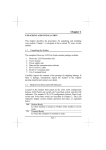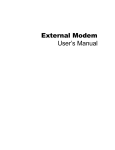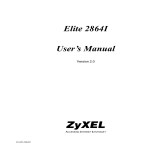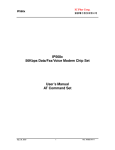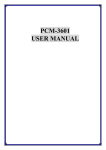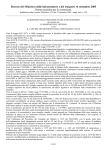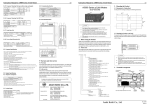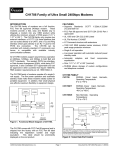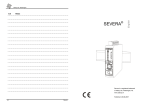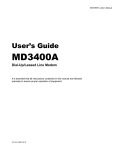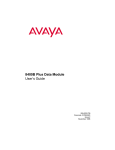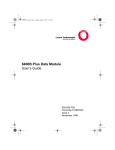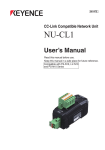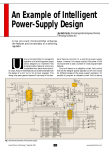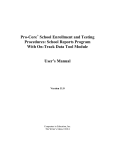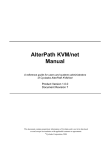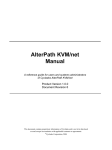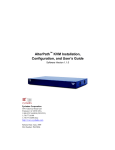Download Chap - VersaLogic
Transcript
PCM-3600 PC/104 Fax/Modem Module Copyright Notice This document is copyrighted, 1996, by AAEON Technology Inc. All rights are reserved. AAEON Technology Inc. reserves the right to make improvements to the products described in this manual at any time without notice. No part of this manual may be reproduced, copied, translated or transmitted in any form or by any means without the prior written permission of AAEON Technology Inc. Information provided in this manual is intended to be accurate and reliable. However, AAEON Technology Inc. assumes no responsibility for its use, nor for any infringements upon the rights of third parties which may result from its use. Acknowledgements AMI is a trademark of American Megatrends, Inc. IBM, PC/AT, PS/2 and VGA are trademarks of International Business Machines Corporation. Intel is a trademark of Intel Corporation. Microsoft Windows® and MS-DOS are registered trademarks of Microsoft Corp. Datatronics, DataSystem, DataTalk, and abcFAX are trademarks of Datatronics Technology, Inc. MNP is a trademark of Microcom, Inc. Cheyenne and BitWare are trademarks of Cheyenne Communications, Inc. Names of computers and software are trademarks of the respective owners. Part No. 2007360000 PCM-3600 Rev. A1 1st Edition Printed in Taiwan December 1996 Packing list Before you begin installing your card, please make sure that the following materials have been shipped: • 1 PCM-3600 PC/104 Fax/Modem module • 1 PCM-3600 user's manual • 1 Fax/Data software disk and users guide • 1 RJ-11 cable • 1 PCM-3600 driver disk for Windows 95 • 1 packet of screws and supports for PC/104 module If any of these items are missing or damaged, contact your distributor or sales representative immediately. Contents 1 Unpacking and Installation .........................1 Introduction ............................................................................ 2 Unpacking And Installation .................................................. 3 A Look at the Modem Card ..................................................... 3 The Serial Port and Interrupt of the Modem Card ................... 4 Setting the COM Port and Interrupt of the Modem Card ........ 4 Installing the Modem Card ...................................................... 5 Testing the Telephone Line Prior to Connection ..................... 6 The Communications Software Configuration ........................ 6 Software Configuration Tips ................................................... 7 Getting Started ......................................................................... 8 2 Modem Fundamentals ...............................9 Modem Fundamentals ......................................................... 10 Modem Basics........................................................................ 10 Data Format ........................................................................... 10 Communications Protocols .................................................... 11 Speeds of the Modem ............................................................ 12 On-Line Speed (DCE Speed) ................................................. 12 Serial Port Speed (DTE Speed) ............................................. 13 Error-Correction and Data Compression (ECDC) ................. 14 Flow Control .......................................................................... 15 Non-Volatile Memory (NVRAM) ......................................... 15 Factory Default Profile (FDP) ............................................... 16 Stored Configuration Profile (SCP) ....................................... 16 Major Stored Configuration Profile (Major SCP) ................. 16 Active Configuration Area (ACA) ........................................ 16 Stored Telephone Numbers (STN) ........................................ 17 3 Modem Operation and Response Codes .19 Modem Operation and Response Codes ............................ 20 Command State and Data State ............................................. 20 The Escape Sequence(+++) ................................................... 20 Issuing Commands ................................................................. 21 Command Buffer ................................................................... 21 Deleting Commands .............................................................. 22 Modem AT Response Codes ................................................. 22 Modem ECDC Response Codes ............................................ 26 4 Basic Modem Commands ........................31 BASIC MODEM COMMANDS ......................................... 32 Answer Command ................................................................. 32 Attention Code [AT] .............................................................. 32 Repeat the Last Command [A/] ............................................. 32 Bell or CCITT Standard [B] .................................................. 33 Transmit Carrier Control [C] ................................................. 33 Dial in Originate Mode [D] ................................................... 33 Command Character Echo [E] ............................................... 33 Hook Control [H] ................................................................... 34 Identifications [I] ................................................................... 34 Speaker Volume Control [L] ................................................. 34 Speaker On-Off Control [M] ................................................. 35 Swap-Dialing [N] ................................................................... 35 Set Redial Times [N=n] ......................................................... 36 Set Redial Interval [N5=n] ..................................................... 36 Read Redial Times [N?] ........................................................ 36 Read Redial Interval [N5?] .................................................... 36 On-Line [O] ........................................................................... 36 Pulse Dialing [P] .................................................................... 37 Response Codes Control [Q] ................................................. 37 Reverse Dialing [R] ............................................................... 37 Dial the Stored Number [S=n] ............................................... 38 Read Register [Sr?] ................................................................ 38 Set Register [Sr=n] ................................................................ 38 Touch-Tone Dialing [T] ......................................................... 39 Word or Digital Response Codes [V] .................................... 39 Response Set Selection [Xn].................................................. 39 Long Space Disconnect [Y] ................................................... 40 Reset [Z] ................................................................................ 40 Auto-dial at Power-On [&An] ............................................... 40 CD Option [&C] .................................................................... 41 DTR Option [&D] .................................................................. 41 Load Factory Default Settings [&F] ...................................... 42 Guard Tone Selection [&G] ................................................... 42 Leased or Dial-Up Line Selection [&L] ................................ 42 Asynchronous or Synchronous Mode Selection [&M] ......... 43 Pulse Dial Selection [&P] ...................................................... 43 Asynchronous or Synchronous Selection [&Q] .................... 44 CTS to RTS Option [&R] ...................................................... 44 Data-Set-Ready (DSR) Option [&S] ..................................... 44 Diagnostics Tests [&T] .......................................................... 44 Read Configuration Profiles [&V] ......................................... 45 Write Configuration Profile [&W] ........................................ 45 Select Store Profile [&Y] ....................................................... 46 Store Telephone Number [&Zn=] ......................................... 46 Wait for Silent Answer [@] ................................................... 46 Pause[,] (Comma) .................................................................. 47 Dial the Stored Number [/n] .................................................. 47 Escape Characters [+++]........................................................ 48 Flash [!] (exclamation) .......................................................... 48 Return to Command State [;] (semicolon) ............................. 48 Ring Control [@B] ................................................................ 49 5 ECDC and Extended Commands ............51 ECDC and EXTENDED COMMANDS ............................ 52 Maximum ECDC Block Size [\A] ......................................... 52 Transmit Break [\B] ............................................................... 52 Auto-Reliable Buffer Option [\C] .......................................... 53 Flow Control in Normal link [\G] .......................................... 54 Serial Port Baud Rate Adjustment [\J] ................................... 54 Set Break Control [\K] ........................................................... 55 MNP Linkage Mode Selection [\L] ....................................... 55 ECDC Operation Mode Selection [\N] .................................. 55 Originate Reliable Link [\O] .................................................. 56 Serial Port Flow Control Option [\Q] .................................... 56 Inactivity Timer [\Tn] ............................................................ 57 Request Reliable Link [\U] .................................................... 57 MNP Response Code Option [\V] ......................................... 57 XON/XOFF Pass-Through [\X] ............................................. 59 Set Auto-Reliable Fallback Character [%An] ....................... 59 Set Modem Port Maximum Baud Rate [%Bn] ...................... 59 Data Compression [%C] ........................................................ 60 Delay Before Forced Hang Up [%Dn] .................................. 60 Automatic Retrain [%E] ........................................................ 60 6 Modem Registers .....................................61 MODEM REGISTERS ....................................................... 62 Reading or Changing a Register ............................................ 62 Auto-Answer Ring Number [S0] ........................................... 62 Ring Count [S1] ..................................................................... 62 Escape Character [S2] ............................................................ 62 Carriage Return Character [S3] ............................................. 63 Line Feed Character [S4] ....................................................... 63 Backspace Character [S5] ...................................................... 63 Wait Time Before Dialing [S6] ............................................. 63 Wait for Carrier After Dial [S7] ............................................ 64 Pause Time for a Comma (,) Dial Modifier [S8] ................... 64 Carrier Detect Response Time [S9] ....................................... 64 Loss of Carrier to Hang Up Delay [S10] ............................... 64 Touch-Tone Dialing Speed [S11] .......................................... 65 Escape Code Guard Time [S12] ............................................ 65 Test Timer [S18] .................................................................... 65 Delay to DTR [S25] ............................................................... 65 RTS to CTS Delay Interval [S26] .......................................... 66 Wait for Connection Password [S48] .................................... 66 7 Diagnostic Tests.......................................67 MODEM DIAGNOSTIC TESTS ....................................... 68 Preliminary Diagnostic Guide ............................................... 68 Using The Test Timer [S18] .................................................. 69 Ending a Test [&T0] .............................................................. 69 Local Analog Loopback Test [&T1] ..................................... 69 Local Digital Loopback Test [&T3] ...................................... 70 Grant or Deny RDL Request [&T4/&T5] .............................. 70 Remote Digital Loopback Test [&T6] ................................... 70 Remote Digital Loopback with Self Test [&T7] ................... 71 Local Analog Loopback with Self Test [ &T8] ..................... 71 A Modem Response Codes ........................73 Modem Response Codes ...................................................... 74 B Command Codes .....................................77 Command Codes .................................................................. 78 C Installing PC/104 Modules .......................83 Installing PC/104 modules................................................... 84 CHAPTER Unpacking and Installation 1 Chapter 1 Unpacking and Installation 1 INTRODUCTION Congratulations on your modem purchase. You have acquired a powerful tool that lets you use a telephone line or leased line to link your computer to others at home or in the office. As a result, you have enhanced the power of your computer and can now exchange information with databases, bulletin boards, and other computer users around the world. The PCM-3600 faxmodem supports the international data communication protocols of CCITT V.34 recommendation at 28,800 bps, as well as, the CCITT V.21, V.22, V.22bis, V.23, V.32, V.FC, V.34 recommendations, and the Bell 103, 212A standards. With the V.23 protocol support, you may use your PCM-3600 to communicate with Videotex services such as BTX and Minitel. Your PCM-3600 provides all basic intelligent features such as autodial, auto-answer, auto-speed adjust, and call progress monitoring. In addition, it is equipped with non-volatile memory so that you may store frequent-use telephone numbers and configuration profiles to gain more accessibility and productivity. By supporting the international error-correction and data compression standards of CCITT V.42bis, V.42 , and MNP Class 2 to 5, your PCM-3600 detects data transmission errors and corrects them on-line. With the installed data compression functions, data throughput is up to four times as fast as a modem without this feature. Consequently, when on-line in V.32bis with V.42bis enabled, the data transfer rate can reach 57,600 bps so your data communications can be completed in only a fraction of the time and cost. Your PCM-3600 is a faxmodem providing full-featured send-andreceive fax communication capabilities. It supports CCITT V.17, V.29, and V.27ter fax protocols at the highest speed of 28,800 bps, and downward compatible to 14,400 bps and below. You may run fax communication software on your computer to directly send or receive fax messages with millions of the fax machines around the world. Data-communication is highly essential in today’s world. We welcome you to our product and services and sincerely hope you enjoy your new modem! 2 PCM-3600 User's Manual UNPACKING AND INSTALLATION The complete modem package should include: 1) The modem unit. 2) This user’s manual. 3) An RJ-11 to RJ-11 phone cable. 4) Data and fax communications software (optional). 5) Windows 95 Driver Carefully inspect the package for shipping damage. If damage is found, repack the modem in the original packing material and contact your dealer. A Look at the Modem Card Fig. 1-1 PCM-3600 Fax/Modem Module 1) 2) 3) 4) 5) 6) Jack for connecting Jack for connecting to the telephone line from the wall outlet Smart/dumb mode select jumper (J6) IRQ select jumper (J4) Com port address slect jumper (J5) PC/104 ISA bus Chapter 1 Unpacking and Installation 3 The Serial Port and Interrupt of the Modem Card You can use any COM port, COM1 to COM4. See your computer manual for the number of ports on your computer. Computers use interrupts (IRQ) to control the data flow between computers and peripherals. An interrupt signals data to flow or to stop, much like a traffic light controls the flow of traffic. Each serial port needs an interrupt to control that particular port. Setting the COM Port and Interrupt of the Modem Card Your modem is factory set for use on COM2 with IRQ3. If you choose to use it with another serial port or interrupt, you need to change the COM jumper and IRQ jumper. Make sure the port and interrupt set-up you use are not used by any other peripheral. The COM/IRQ settings should appear as in the diagram below. If you have any questions about setting a port for your modem, consult your dealer. Fig. 1-2 Fax/Modem Module COM/IRQ Setting 4 PCM-3600 User's Manual Installing the Modem Card The modem card is designed for reliability, but it should be kept away from static electricity, shock, heat, and humidity. Install the modem into your computer as follows. 1) Turn off the computer 2) Remove the cover of your computer and locate the PC/104 expansion slot. Refer to your computer’s installation guide. 3) Plug in your PC/104 modem to the expansion slot, and make sure the connectors of the modem card are exactly aligned with the expansion slot. 4) Secure the modem card to the computer with screw. 5) Connect the telephone line from the wall outlet to the jack labeled LINE. 6) Connect the line from your telephone to the jack labeled PHONE. You may leave the PHONE jack unconnected. CAUTION: Handle the card only by its edges. The card’s precision components are easily damaged by static electricity or abuse. The metal bracket of the modem card should rest firmly on the rear panel bracket of the computer. If not, remove the modem card and try again. Chapter 1 Unpacking and Installation 5 Testing the Telephone Line Prior to Connection The quality of the telephone line significantly affects the reliability and quality of data communications. Make sure that both the telephone system and telephone line are in good order before the modem is connected. Test the line by lifting the telephone handset and listening for a clear dial tone. Try placing a few calls. If the calls do not go through well or are not loud and clear, you may have a poor quality telephone line. In this case, find a better quality line for your modem to ensure reliable data communications. We strongly recommend that you connect the modem directly to an outside telephone line. Do not connect your modem to a Private Branch Exchange (PBX) telephone system unless the system is proven to perform well under data transmission conditions. The Communications Software Configuration Your modem follows the standard modem command set. Most of the popular communications software packages work with your modem. If you have any problem using the software, please contact your software dealer, publisher, or modem dealer. To install the software, turn on your computer and modem, and boot the communications software. Follow the software manual’s instructions to execute software installation. Software configuration procedures vary with each software program, computer, and application. Refer to your software manual for more information. If you experience any difficulty, consult your dealer. When installing the software, pay particular attention to the following parameter settings, as many beginners fail to successfully set them correctly. 6 PCM-3600 User's Manual 1) The serial port number. 2) The communications protocol. 3) The data format, including data bit, stop bit, and parity. The serial port specified in your communications software must match the serial port to which the modem is actually connected. No matter whether it is COM1, COM2, COM3, or COM4, a port can be only be connected to one peripheral device, and should be specified so. Otherwise, the two devices will conflict with one another, or your computer will not be able to find the proper COM port or other device. To communicate successfully, the protocol and data format of the two modems on-line must be identical. For example, if the bulletin board you are going to dial supports Bell standard, 8 data bits, no parity, 1 stop bit, you should specify this set-up exactly. Otherwise, the connection will be unsuccessful and any data received will be unreadable (garbled). Software Configuration Tips For most PC data communication applications using up-to-date communication software, the factory default settings are sufficient. However, you may have to reconfigure your modem if this is not the case. Almost all compatible software applications use a similar dialing prefix command summary. If required, you can use the command summary to overwrite modem parameters. Most popular communication software packages allow users to specify a command string and the dialing prefix that is sent to the modem prior to dialing telephone number digits. The dialing prefix reconfigures the modem according to your commands. Below are some examples of a dialing prefix string: ATS0=3 Instructs the modem to auto-answer an incoming call on the third ring. Chapter 1 Unpacking and Installation 7 ATX4DT9W Instructs the modem to first tone-dial the number 9 and hold it until a dial tone is detected. ATS6=10DP Instructs the modem to wait for 10 seconds before proceeding to dial. ATM2L3DT Turns on the modem monitoring speaker at all times, and uses high volume. ATB0DTUses the CCITT protocol to establish connection with the remote modem. AT&P1DP Pulse dials with the make/break ratio of 33/67 (for use in most European countries). AT&P0DP use in the USA). Pulse dials with the make/break ratio of 39/61 (for You may use any command or combination you need. Refer to the chapters in this manual regarding modem commands for more details. Getting Started Now, you can dial a bulletin board, data base, or remote computer. Your modem establishes the connection automatically. Once there is a connection, you can, 1) read or send electronic mail, 2) view up-to-date news or information, 3) upload or download computer programs, 4) transmit or receive a text message or spread sheet data, or perform whichever on-line data communication tasks you require. Note that the remote modem should be set to accept digital loopback request by issuing AT&T4. 8 PCM-3600 User's Manual CHAPTER Modem Fundamentals 2 Chapter 2 Modem Fundamentals 9 Modem Fundamentals This chapter provides a brief overview of how modems work. Modem Basics Modems let computers communicate with other computers using normal telephone lines or leased lines. Your modem sends communications by modulating (converting) data into sound waves that a telephone can transmit and another modem can receive. Your modem receives communications by demodulating sound waves from the telephone into data your computer can recognize. The term modem is an abbreviated way of describing this modulation/demodulation process. In addition to converting data to sound, a modem performs functions such as dialing, answering calls, and adjusting settings for local telephone conditions. Commands must be issued to the modem to control these functions and settings. Data Format In asynchronous serial communications, data bytes are disassembled into individual bits and then transmitted bit by bit along with interval bits and checksum bits, in the order of start bit, data bits, parity, stop bits, and so on. The interval bits, start bit, and stop bit, signal to the receiving party the beginning and end of a byte. The checksum bit and parity allow the receiving party to check the accuracy of the received data. The pattern in which a byte is disassembled is called the data format. Modems at both ends of a link should use the same data format. Otherwise, the data may be misinterpreted and appear garbled. The most commonly used data formats include the following types. Before you dial a bulletin board or connect on-line with any remote modem, make sure your modem supports the required data format, your software can specify the required data format, and that you have specified the correct data format. Start Bit Data Bits Parity Stop Bit Total 1 8 none 1 10 1 7 none 2 10 1 7 even, odd 1 10 1 7 mark, space 1 10 Communications Protocols Two popular groups of communications protocol are currently used in data communications throughout the world, the Bell standard and the CCITT recommendation. For 1200 bps protocols, the Bell standard is used mainly in the United States and Canada, while the CCITT standard is used in most other countries. For 2400 bps and faster protocols, the CCITT standards are used internationally. The following table shows common communications protocols listed from the highest to the lowest DCE speed. DCE Speed Bell CCITT Synchronous 28800bps N/A V.34 async/sync 14400 bps N/A V.32bis (TCM) async/sync 9600 bps N/A V.32 (QAM & TCM)async/sync" 2400 bps N/A V.22bis async/sync 1200/75 bps N/A V.23 Main (host) async 75/1200 bps N/A V.23 Back (user) async 1200 bps 212A V.22 async/sync 0-300 bps 103 V.21 async Chapter 2 Modem Fundamentals 11 Data communications requires that both modems on a link use the same protocol. The protocol determines the communications speed and transmission standard (Bell or CCITT). To change protocols, you can issue a B command and the modem automatically goes to the highest speed of that protocol. If you want to specify a particular protocol speed, issue a %B command. Speeds of the Modem During an on-line communications path, your modem is located between the local computer and remote modem. It has to communicate with both the remote modem and local computer, through the telephone line and serial port cable, respectively. Figure 1-1 describes the DCE speed relationship between modems. The speed over the telephone line at which your modem communicates with the remote modem is called the on-line speed. Since the modem is Data Communications Equipment, the communications speed is called the DCE speed. On the other hand, the speed over the serial port at which your modem communicates with the local computer is called the serial port speed. Since the computer is Data Terminal Equipment, it is called the DTE speed. On-Line Speed (DCE Speed) Your modem supports one or more communication protocols, depending on its modem type. When your modem answers a call and establishes a connection, it adjusts its speed according to that of the calling modem. As a result, the speed at which the calling modem dials becomes the on-line speed. Serial Port Speed (DTE Speed) Each time the modem receives a command string from the computer, the AT prefix instructs the modem of the serial port speed. This speed remains as the active serial port speed, (i.e., the active speed DTE speed). For example, if your modem is set at 2400 bps and the remote modem is calling at 1200 bps, the connection is established at 1200 bps. Your modem sends the response code “CONNECT 1200” at 2400 bps to the local computer and then adjusts its DTE speed to 1200 bps. Your modem will no longer recognize characters received from the local computer at 2400 bps. If you are writing communications software, be sure to have the local computer determine the speed from the response code and adjust its serial port speed accordingly. In normal applications, the baud rate adjustment capability of your modem should be enabled so that the DTE speed shall always follow the DCE speed. you can issue the \J command to turn the serial port adjustment on or off. However, in a reliable link or a direct link the baud rate adjustment capability may be disabled, so that the serial port speed may be different to the on-line speed. If data comes in faster than it goes out, the faster incoming data is stored in the data buffer. Therefore, when flow control capability is enabled, it is advisable that the on-line (DCE) speed be at a rate equal to or higher than the serial (DTE) port speed. Otherwise, data may be lost after the buffer is full. Chapter 2 Modem Fundamentals 13 Error-Correction and Data Compression (ECDC) Many modems support error-correction and data compression (ECDC) protocols. Error-correction assures error-free data transmission because the modem re-transmits the incorrect block of data once a transmission error is detected. Data compression can increase data throughput which results in savings of transmission time and telephone bill costs. Common ECDC protocols include CCITT V.42, V.42bis, and MNP 2-5. The CCITT V.42 recommendation offers an error-correction protocol referred to as LAPM (Link Access Procedure for Modems), which is the modem protocol for point-to-point communications. The CCITT V.42bis provides both error-correction and data compression features. In addition to its compatibility to V.42 in errorcorrection, V.42bis offers a 4:1 data compression rate so that data can be transferred up to 4 times faster than a non-MNP modem. For example, a 14,400 bps modem can reach a data throughput of 57,600 bps when the compression rate is 4:1 on a V.42bis ECDC link. However, the true compression rate depends on the pattern of the transmission file. As an alternative to CCITT recommendations, MNP Class 2 to 4 offers error-correction capability, while MNP Class 5 offers a 2:1 data compression. The MNP protocol was popular before CCITT ECDC protocols were released and there are still some modems using this protocol. Note that V.42/V.42bis and MNP are different both in format and operation. Two modems must support the same ECDC protocol in order to connect in ECDC mode. For example, a V.42bis modem connects in V.42bis mode only when the remote modem also supports the V.42bis protocol. For example, if your modem supports all three ECDC protocols, but the remote modem only supports MNP5, the connection can only be established in MNP5 mode. You should use the V.42bis recommendations as long as the on-line modem at the remote end supports the same. This way, you can achieve higher data throughput. To select the ECDC mode, use the command \N. Flow Control While on-line, your modem is between your computer and the remote modem (or the remote computer, if you consider the remote modem as a transparent device). Your modem communicates with your computer (the local computer) through RS-232 serial port interface, and communicates with the remote modem via telephone line. If data comes to your modem faster than it goes out, some data may be lost because your modem can not pass on all the received data to the other end. To overcome this problem, your modem is equipped with a data buffer to store excess data received. Once the buffer is full, your modem must signal the sending device to stop transmission. When the buffer is clear, your modem signals to resume data transmission. This is called flow control. Two kinds of flow control methods are commonly used, the hardware flow control and the software flow control. Hardware flow control is also called RTS/CTS control, as it uses the RS-232 hardware signals (RTS and CTS) to stop or resume data transmission. This is the best method of flow control because you can send any data characters using this method. The software flow control uses two data characters (XON and XOFF) to indicate when the sending device shall stop or resume. Since it uses data characters as control, you can not send binary data or filetransfer protocols such as XMODEM with this type of flow control. To select a method for flow control, use command \Q. You should use hardware flow control at all times, if your modem supports it. Non-Volatile Memory (NVRAM) The NVRAM is a special type of read-write memory element which can retain data even when the power is turned off. Your modem’s NVRAM retains configuration profiles and telephone numbers. The NVRAM does not require a back up battery so that you can eliminate the threat of data loss due to a dead battery, as well as avoid Chapter 2 Modem Fundamentals 15 hardware damage due to electrolyte leakage. Factory Default Profile (FDP) The FDP is the default configuration profile stored in your modem’s read-only memory (ROM), which can not be modified by the user. The FDP is intended for rescuing the modem in case the user misconfigures the modem’s settings. To display the FDP, use command &F to place the profile into the active configuration area (ACA), then issue AT&V. Note that some modems may have more than one built-in FDP; in which case, each FDP serves as the default for a particular application requirement. Stored Configuration Profile (SCP) The SCP is the configuration profile stored in the NVRAM of the modem to be retrieved for later use. Initially the factory sets the SCPs identically to the FDPs. To view all the SCP configurations, issue command &V. note that once an SCP is selected and loaded into ACA, it becomes the major SCP and provides the control characteristics of the modem. If you hav edited the ACA and wish to write it to an SCP, issue a &W command. The modified configuration profile overwrites the original SCP and becomes the new SCP. For information on the SCPs of your particular modem, refer to your Getting Started manual. Major Stored Configuration Profile (Major SCP) The major SCP is the SCP that is loaded into the ACA each time the modem is turned on or reset by ATZ. To designate an SCP as the major SCP, issue &Y followed by the SCP number. For example, issuing &Y1 designates SCP1 as the major SCP. Active Configuration Area (ACA) The ACA is a portion of the random-access-memory (RAM) in your modem that holds the configuration settings that determine the modem’s current operating characteristics. When the modem is turned on or reset by command ATZ, the ACA is first loaded with the FDP, and then is overwritten by the major SCP. The commands you issue to the modem actually change the contents of the ACA. However, once the modem is turned off, all the settings in the ACA vanish. To save the current ACA configuration to a SCP for further use, issue command &W followed with the number of the SCP. For example, issue &W1 saves the current configuration to SCP1. The next time you want to use the same configuration, just issue AT&1 to load the ACA with the SCP1 previously saved. Issuing &V0 command displays the current configuration profile, the stored configuration profiles, as well as the current speed, data format, parity and protocol. Stored Telephone Numbers (STN) The STN are the digits retained in the modem’s NVRAM and used for speed dialing. You may use it to save frequently used telephone numbers, passwords, or credit card numbers. To store a telephone number as an STN, use &Z followed by the STN number, the"=" sign, and the telephone number. For example, &Z2=886-2-9130792 stores 88629130792 as STN2. Note that only digits can be stored in STN. Other characters or symbols are discarded. To view the STN, issue command &V1. To dial an STN, issue S=n, Chapter 2 Modem Fundamentals 17 CHAPTER 3 Modem Operation and Response Codes MODEM OPERATION AND RESPONSE CODES This chapter describes modem states, commands and response codes and explains how to issue commands to the modem. Command State and Data State During operation, your modem is either in command state or data state. The figure below shows the relationships between the two states and how to enter and abort from each of them. In command state, the modem interprets all the characters it receives as commands. The command state may either be on-line or off-line. When the modem is holding a connection with a remote modem or when it is in an analog loopback test, it is on-line. Otherwise, it is offline. In data state, the modem is a transparent receiving and sending device. It assumes everything it receives (except the escape sequence) as data and conveys them to the local computer or remote system. The Escape Sequence(+++) The escape sequence instructs the modem to leave (escape) the data state and enter the command state, without breaking the connection. It is the only data string that is interpreted as a command when the modem is in data state. After switching to command state, the user can issue further commands, such as changing parameter settings, etc. To resume data state, simply issue ATO. The escape command in default is three consecutive “+” characters. For the modem to distinguish the escape command from the data, a certain duration of guard time is defined to exist both prior to and after the three consecutive escape characters. The escape sequence includes a guard time, three consecutive escape characters, and a guard time, in that order. The default guard time is 1 second. It can be changed by assigning a different value to register S12. 20 PCM-3600 User's Manual In the same manner, you may change the escape character to a different one by assigning the ASCII value (in decimal) of the new escape character to register S2. Issuing Commands When the modem is in command state, you can issue commands to the modem by typing them on the keyboard. A command line shall always begin with AT (or at), followed by the command or commands, and completed with a return key. The only exception is A/, which does not require the AT prefix and a return key. Some commands, such as M1, M2 or M3, require a parameter after the command letter. If the parameter is missing, the modem treats the command as having a parameter of 0. For example, M would be recognized as M0. When multiple commands are issued in a command line, you can insert spaces between commands to make the command line easier to read. Command Buffer The command buffer has a capacity of 40 characters. All the commands you type on the keyboard are stored in the command buffer before the return key is pressed. However, the AT or at, the carriage return, the optional line feed characters, and the spaces in the command line are not stored in the command buffer. The command line stored in the command buffer is not executed until you have pressed the return key. If the command buffer overflows, the modem sends the ERROR response code upon receiving the carriage return character, and all the commands in the command buffer are ignored. Deleting Commands If you make a mistake while typing a command line, you can press the backspace key to delete the last character you have entered. However, the backspace key does not delete the AT prefix. To delete the entire command line, press the backspace key until every command character (except AT) is deleted. Then, press the return key. You may change the backspace character to another ASCII character by assigning a new value to register S5. For example, ATS5=27 designates ESC as the backspace character. Modem AT Response Codes Unless you have instructed the modem not to send response codes by issuing command Q1, it will always send a response code after executing a command line. The response code can be displayed in word or in digit form depending on the V command issued. Command X0 to X4 lets you select different response sets of the modem, which enables or disables certain response codes. In general application, you can select X4, the default, which enables all response codes so that the most specific response message can be displayed. If you plan to write your own software for special applications, you may select the response set you require by issuing an appropriate X command. The following table shows the response codes from 0 to 8 related to each command. The means the response code is disabled for the corresponding command. The remaining response codes are enabled 22 PCM-3600 User's Manual by key command x1, x2, x3, x4 (but disabled by key command x0). Response Code Commands to enable the response code 0 OK x0 x1 x2 x3 x4 1 CONNECT x0 x1 x2 x3 x4 2 RING x0 x1 x2 x3 x4 3 NO CARRIER x0 x1 x2 x3 x4 4 ERROR x0 x1 x2 x3 x4 5 CONNECT 1200 - x1 x2 x3 x4 6 NO DIAL TONE - - x2 - x4 7 BUSY - - - x3 x4 8 NO ANSWER - - x2 x3 x4 Selected response codes are listed below. Each number on the left is the digit equivalent (short form) of the response code. 0 OK The command line stored in the command buffer has been executed without error. 1 CONNECT Modem has successfully established a connection with a remote modem. It denotes either a connection is established at 300 bps (when X1, X2, X3, or X4 is in effect) or a connection is established at any speed (when X0 is in effect). 2 RING Modem has detected an incoming ring. The code RING is displayed on the screen repeatedly as each consecutive ring is detected until the modem goes off- hook to answer the call. 24 3 NO CARRIER Modem has either failed to detect a carrier within 45 seconds (determined by register S7) while dialing or answering. Modem detects a loss-of-carrier when it is on-line with a remote modem or detects a loss-ofcarrier when it is performing a local analog loopback test. 4 ERROR Modem has encountered an invalid command when executing the command line stored in the command buffer; or an overflow has occurred in the command buffer (too many characters were entered into the command line). 5 CONNECT 1200 Modem has successfully established a connection with a remote modem at 1200 bps. (enabled when X1, X2, X3, or X4 is in effect) 6 NO DIAL TONE Modem has failed to detect a dial tone. (enabled by dial modifier W when command X2, or X4 is in effect). 7 BUSY Modem has detected a busy signal after dialing a phone number (enabled by the dial modifier @ when X3, or X4 is in effect). 8 NO ANSWER Modem has failed to detect a 5-second silence within the 45 second (determined by register S7) waiting period (enabled by the dial modifier @ when X3, or X4 is in effect). 10 CONNECT 2400 Connection has been successfully established at 2400 bps. (enabled when X1, X2, X3, or X4 is in effect) 11 CONNECT 4800 PCM-3600 User's Manual Connection has been successfully established at 4800 bps. (enabled when X1, X2, X3, or X4 is in effect) 12 CONNECT 9600 Connection has been successfully established at 9600 bps. (enabled when X1, X2, X3, or X4 is in effect) 13 CONNECT 7200 Connection has been successfully established at 7200 bps. (enabled when X1, X2, X3, or X4 is in effect) 14 CONNECT 19200 Connection has been successfully established at 19200 bps. (enabled when X1, X2, X3, or X4 is in effect) 15 CONNECT 14400 Connection has been successfully established at 14400 bps. (enabled when X1, X2, X3, or X4 is in effect) 16 CONNECT 38400 Connection has been successfully established at 38400 bps. (enabled when X1, X2, X3, or X4 is in effect) 17 CONNECT 57600 Connection has been successfully established at 57600 bps. (enabled when X1, X2, X3, or X4 is in effect) Modem ECDC Response Codes The following MNP and V.42 response codes appear after executing a command line. Note that the following response codes are enabled depending on the \V command when X1, X2, X3, or X4 are in effect. In MNP mode, the identifier /REL denotes the modem is in reliable link with error-correction, while /REL COMP denotes both errorcorrection and data compression are enabled. In CCITT V.42bis or V.42 modes, the identifier /V.42 means errorcorrection is enabled, while /V.42bis denotes both error-correction and data compression are enabled. 26 20 CONNECT 300/V42 (REL) Connection has been successfully established at 300 bps in reliable mode with or without data compression. 21 CONNECT 600/V/42 (REL) Connection has been successfully established at 600 bps in reliable mode with or without data compression. 22 CONNECT 1200/V42 (REL) Connection has been successfully established at 1200 bps in reliable mode with or without data compression. 23 CONNECT 2400/V42 (REL) Connection has been successfully established at 2400 bps in reliable mode with or without data compression. 24 CONNECT 4800/V42 (REL) Connection has been successfully established at 4800 bps in reliable mode with or without data compression. 25 CONNECT 9600/V42 (REL) Connection has been successfully established at 9600 bps in reliable mode with or without data compression. PCM-3600 User's Manual 26 CONNECT 19200/V42 (REL) Connection has been successfully established at 19200 bps in reliable mode with or without data compression. 27 CONNECT 7200/V42 (REL) Connection has been successfully established at 7200 bps in reliable mode with or without data compression. 28 CONNECT 14400/V42 (REL) Connection has been successfully established at 14400 bps in reliable mode with or without data compression. 29 CONNECT 38400/V42 (REL) Connection has been successfully established at 38400 bps in reliable mode with or without data compression. 2A CONNECT 57600/V42 (REL) Connection has been successfully established at 57600 bps in reliable mode with or without data compression. 30 CONNECT 300/V42BIS (REL COMP) Connection has been successfully established at 300 bps in reliable mode with data compression. 31 CONNECT 600/V42BIS (REL COMP) Connection has been successfully established at 600 bps in reliable mode with data compression. 32 CONNECT 1200/V42BIS (REL COMP) Connection has been successfully established at 1200 bps in reliable mode with data compression. 33 CONNECT 2400/V42BIS (REL COMP) Connection has been successfully established at 2400 bps in reliable mode with data compression. 34 CONNECT 4800/V42BIS (REL COMP) Connection has been successfully established at 4800 bps in reliable mode with data compression. 35 CONNECT 9600/V42BIS (REL COMP) Connection has been successfully established at 9600 bps in reliable mode with data compression. 28 36 CONNECT 19200/V42BIS (REL COMP) Connection has been successfully established at 19200 bps in reliable mode with data compression. 37 CONNECT 7200/V42BIS (REL COMP) Connection has been successfully established at 7200 bps in reliable mode with data compression. 38 CONNECT 14400/V42BIS (REL COMP) Connection has been successfully established at 14400 bps in reliable mode with data compression. 39 CONNECT 38400/V42BIS (REL COMP) Connection has been successfully established at 38400 bps in reliable mode with data compression. 3A CONNECT 57600/V42BIS (REL COMP) Connection has been successfully established at 57600 bps in reliable mode with data compression. 40 CONNECT 300/NOR Connection has been successfully established at 300 bps in normal mode. 41 CONNECT 600/NOR Connection has been successfully established at 600 bps in normal mode. 42 CONNECT 1200/NOR Connection has been successfully established at 1200 bps in normal mode. 43 CONNECT 2400/NOR Connection has been successfully established at 2400 bps in normal mode. 43 CONNECT 2400/NOR Connection has been successfully established at 2400 bps in normal mode. 44 CONNECT 4800/NOR Connection has been successfully established at 4800 bps in normal mode. PCM-3600 User's Manual 45 CONNECT 9600/NOR Connection has been successfully established at 9600 bps in normal mode. 46 CONNECT 19200/NOR Connection has been successfully established at 19200 bps in normal mode. 47 CONNECT 7200/NOR Connection has been successfully established at 7200 bps in normal mode. 48 CONNECT 14400/NOR Connection has been successfully established at 14400 bps in normal mode. 49 CONNECT 38400/NOR Connection has been successfully established at 38400 bps in normal mode. 4A CONNECT 576400/NOR Connection has been successfully established at 57600 bps in normal mode. 30 PCM-3600 User's Manual CHAPTER Basic Modem Commands 4 BASIC MODEM COMMANDS This chapter describes the basic modem commands in alphabetical order. Some commands have factory default settings, for which you can refer to your Getting Started manual’s Command Summary table. Answer Command Range: n=0-255 Unit: Rings Command A instructs the modem to immediately answer incoming calls. The number of rings by which the modem goes off-hook to answer is determined by the register S0. Alternatively, if a number follows the A command, the modem goes off-hook to answer on the specified rings. For example, A3 instructs the modem to auto-answer on the third ring. The modem will enter data state after a connection is successfully established. Attention Code [AT] Command AT clears the command buffer and informs the modem of your computer’s transmission speed and data format. Any command line except A/, must start with AT prefix and end with a carriage return. Repeat the Last Command [A/] Command A/ instructs the modem to re-execute the last command line stored in the command buffer. This is the only command that does not need an AT prefix and a carriage return. 32 PCM-3600 User's Manual Bell or CCITT Standard [B] This command is used to select the communications protocols as follows: B0 Selects CCITT protocol, which is used in Europe and most countries in the world. B1 Selects Bell protocol, which is mainly used in the U.S. and Canada. B2 Selects V.23 Back channel (user side). B3 Selects V.23 Main Channel (host side). Transmit Carrier Control [C] C0 Disable Transmit Carrier C1 Enable Transmit Carrier Dial in Originate Mode [D] Command D instructs the modem to dial the number following it and enter the data state after a connection is established. The number following command D may include the digits 0-9; the symbols * and #; and dial modifiers P, T, R, W, S=n and others. Command Character Echo [E] This command is used to enable or disable the echo of the command characters back to the computer. It is only effective in command mode. E0 Disable the echo of command characters. It is used when the command characters appear double on your screen or when you use a modem with a host computer and you want the command characters to be echoed. E1 Enables the modem to echo command characters to your computer so that you can view and verify the command line on the screen. Hook Control [H] This command instructs the modem to go off-hook (use the telephone line) or to go on-hook (hang-up). H0 Modem goes on-hook. H1 Modem goes off-hook. Identifications [I] This command allows the checking of the modem’s product code, firmware version, and executes firmware test as follows: I0 Displays the modem’s product code. I1 Displays the checksum code of the modem’s firmware ROM in ASCII digits followed by a carriage return and a line feed. I2 Executes the modem’s checksum test and sends an OK or ERROR response code, accordingly. Speaker Volume Control [L] This command adjusts the volume of the modem speaker for call progress monitoring, when the speaker is turned on. 34 L0 Selects low speaker volume L1 Selects low speaker volume L2 Selects medium speaker volume L3 Selects maximum speaker volume PCM-3600 User's Manual Speaker On-Off Control [M] This command turns on or off the modem’s speaker for call progress monitoring, as follows: M0 Turns the speaker off at all times. M1 Turns the speaker on until a connection is established. M2 Turns the speaker on at all times (even after a connection has been established). M3 Turns the speaker on until a carrier is detected, but, turns the speaker off when the modem is dialing. Swap-Dialing [N] Inserting command N between two telephone numbers in a dial command line causes the modem to swap-dial the second specified number if the first one is busy. For example, given the following command line, AT DT X4 782-0002 N 788-3380 the modem dials 782-0002 first. If 782-0002 is busy, the modem swap-dials 788-3380. To use swap dialing, either X2 or X4 must be in effect so that the modem can detect a busy signal. Make sure that the total number of characters in a command line, excluding spaces, does not exceed 80. If it exceeds 80, the command buffer overflows. However, the speed dialing command, /n, is counted as 2 digits in the comand buffer, while S=n is counted as 3 digits, regardless of the number of digits stored in the STN. Do not confuse this N command with the redial times commands N=n or N?. Set Redial Times [N=n] Range: n=0-15 Unit: Times Default: 0 This command determines how many times the modem will redial a call if a busy signal is detected. The default is N=0 so that the modem does not redial. The redial times counter is cleared to 0 after a connection is made, command Z or &F is issued, or dialing is aborted by the user. Set Redial Interval [N5=n] Range: n=0-255 Unit: 2 seconds Default: 1 This command adjusts the interval between redials. For example, issuing N5=45 commands the modem to redial a call every 90 seconds. Read Redial Times [N?] Issue command N? to display the current setting of your modem’s redial times. For example, if you issue N? and the response is 5, it means the redial time is set for 5 times. Read Redial Interval [N5?] Issue N5? to display the interval between two redials. For example, if you issue N5? and the reesponse is 45, the redial is executed every 90 seconds. On-Line [O] This command instructs the modem to enter on-line data state. O 36 Causes the modem to enter on-line data state and to resume data transmission with the remote modem. PCM-3600 User's Manual O1 Causes the modem to enter on-line data state, and initiates an equalizer retrain sequence at the same speed. This is used when bit error rates are excessive and a retrain may reduce the errors attributed to a loss of equalization. Note that this command is effective only at 2400 bps or above. O2 Causes the modem to enter on-line data state and initiates a V.32 forward-speed retrain sequence. O3 Causes the modem to enter on-line data state and initiates a V.32 backward-speed retrain sequence. Pulse Dialing [P] Inserting command P before a telephone number instructs the modem to use pulse dialing to dial the number. You may insert P anywhere in a dial command line, even between digits. For example, the command line AT DT 9 , P 913-0792 instructs the modem to tone-dial 9, wait for two seconds (comma character), then pulse dial the number 913-0792. Response Codes Control [Q] This command enables or disables the sending of a response codes after a command line is executed. Q0 Enable the sending of response codes. Q1 Disable the sending of response codes. This feature is useful when the modem is connected to a printer that may print out undesired response codes characters. Reverse Dialing [R] Dial in dialing Tone and then change to answering mode after connection. Dial the Stored Number [S=n] Issuing dial modifier S=n after the dial command D instructs the modem to dial the stored telephone number (STN) previously saved with the &Z command. For example, AT&Z2=913-0792 Save 913-0792 to STN2 ATDTS=2 Dial 913-0792 (STN2) ATDT886-2S=2 Dial 886-2-913-0792 (8862 plus STN2) ATDTS=2NS=4 Dial STN2. If STN2 is busy, swap-dial STN. When the dial modifier S=n is used, the command buffer counts the S=n as only 3 characters. Do not confuse this dial modifier command with the register command Sr? or SR=n. The dial modifier S= must be preceded by a dial command D, DT, or DP. Read Register [Sr?] Issuing command Sr? Displays the content of register S. For example, ATS7? displays the value stored in register S7. You may read multiple registers at a time. For example, ATS5?S7? displays both the values in register S5 and S7. Set Register [Sr=n] Command SR=n changes the value of register r to n. For example, ATS0=3 sets register S0 to 3. When the modem is turned off or is reset by command ATZ, all the register values resume to the default values. If you want to save the changes for further use, you should issue command &W to save the value to SCP. 38 PCM-3600 User's Manual Touch-Tone Dialing [T] Inserting command T before a telephone number instructs the modem to tone-dial the number. The speed of tone-dialing is determined by register S11 which is set to default at about 5.26 digits per second. You may insert command T anywhere in a dial command line, even between digits, to have the modem tone-dial the following digits. For example, the command line, AT DP 9 , T 913-0792 instructs the modem to pulse dial 9, wait for two seconds (for the comma character), then tone-dial 913-0792. Word or Digital Response Codes [V] This command instructs the modem to send response codes in either word form or digit form as follows: V0 Send response codes in digital form. This form is convenient when using the modem with software that does not handle character strings efficiently. V1 Send response codes in word form, such as OK or CONNECT. This form is easier for the user to read. Response Set Selection [Xn] Range: 0 to 4 Default: 4 This command determines which response code shall be enabled or disabled. See the section of response code for more information. Long Space Disconnect [Y] This command enables or disables the long space disconnect feature of the modem. Y0 Disables long space disconnect. Y1 Enables long space disconnect. The modem will hang up when it receives a 1.6 seconds continuous break signal. Also, it will send a 4-second break signal before disconnecting when it receives command ATH or when it detects a DTR ON-to-OFF transition if &D2 option is selected. Reset [Z] This command resets the modem with factory defaults (FDP), and a stored configuration profile (SCP). It also performs a modem self test. Some modems have additional SCPs, for which you should refer to your Getting Started manual. Z1 Reset the modem with SCP1. Z2 Reset the modem with SCP2. Auto-dial at Power-On [&An] An A99 40 Range = 0 ~ 9 or 0 ~ 3 Enable modem to Auto-dial the n-th STN and make connection when power is on. Disable Auto-dial at power on function. PCM-3600 User's Manual CD Option [&C] This command determines how the modem reacts to the conditions of a CD (Carrier Detect) interchange circuit. &C0 CD is always forced ON. &C1 The modem tracks the data carrier from the remote one and initials CD accordingly. &C2 CD is forced on during command state, but it is tracked on connection. DTR Option [&D] This command determines how the modem reacts to a DTR (Data Terminal Ready) on-to-off transition. &D0 Instructs the modem to ignore DTR. &D1 Instructs the modem to assume command state upon the detection of a DTR on-to-off transition but maintain an active line connection. &D2 Instructs the modem to go on-hook, assume command state, and disable auto-answer upon the detection of a DTR on-to-off transition. The auto-answer function can be re-enabled by turning DTR on again. &D3 Instructs the modem to re-initialize itself when it detects a DTR on-to-off transition. The ACA will be overwritten by the active SCP. &D4 Instructs the modem to deliver all buffered data before disconnecting to on-to-off transition. This command is only valid in asynchronous mode. In synchronous mode, a DTR on-to-off transition always causes the modem to disconnect. Load Factory Default Settings [&F] Command &F loads the factory default profile (FDP) into the modem’s Active Configuration Area (ACA). Your modem then functions using the FDP paramters. When the FDP is in ACA without being changed, you may view the FDP settings by issuing command &V. &F0 Restore factory FDP0 default to ACA. &F1 Restore factory default FDP1. Guard Tone Selection [&G] The command &G lets you select the guard tone in CCITT V.22 and V.22bis mode. It is effective only in these modes. The guard tone is not required by the Bell protocol. &G0 Disables guard tone transmission. &G1 Selects the guard tone of 550 Hz. &G2 Selects the guard tone of 1800 Hz. Leased or Dial-Up Line Selection [&L] This command selects either dial-up line or leased line operation for the modem. 42 &L0 Sets the modem for dial-up line operation. &L1 Sets the modem for leased-line operation dedicated between two destinations. PCM-3600 User's Manual Asynchronous or Synchronous Mode Selection [&M] This command is issued depending on whether you want to use the modem in synchronous or asynchronous communications mode. Your modem may not provide all of the commands listed below. Check your Getting Started manual to see which of the following commands your modem provides. &M0 Sets the modem to asynchronous mode to accept the asynchronous commands. &M1 Sets the modem to synchronous mode 1, the asynchronous dialing synchronous mode. &M2 Sets the modem to synchronous mode 2, the dial stored number synchronous mode. &M3 Sets the modem to synchronous mode 3, the manual dial synchronous mode. &M4 Sets the modem to asynchronous mode and to autodial STN0 when DTR goes on or when the voice/data switch is toggled to data. Note that command &M0 to &M3 has the same function as the &Q commands. Pulse Dial Selection [&P] This command is used to determine some of the characters in relation to pulse dialing method. It is in effect only when the modem uses pulse dialing. &P0 Selects the make/break ratio of 39/61 for use with modems in countries such as the U.S.A. and Canada. &P1 Selects the ratio of 33/67 for use with modems in countries such as the United Kingdom or Hong Kong. Asynchronous or Synchronous Selection [&Q] This command has the same function as command &M. See the &M command section for details. Your modem may not provide all of the commands listed below. Check your Getting Started manual to see which of the following commands your modem provides. &Q1 Sets the modem to synchronous mode 1, the asynchronous dialing synchronous mode. &Q2 Sets the modem to synchronous mode 2, the dial stored number synchronous mode. &Q3 Sets the modem to synchronous mode 3, the manual dial synchronous mode. CTS to RTS Option [&R] This command determines how the modem will react to CTS/RTS (Clear To Send, Request To Send) signal. It is in effect only in synchronous mode. &R0 CTS tracks the condition of the RTS. &R1 RTS ignored and the CTS is forced on. Data-Set-Ready (DSR) Option [&S] This command determines how the modem will operate the DSR (Data Set Ready) signal. It is in effect only in synchronous mode. &S0 DSR is forced on. &S1 DSR operates in accordance with the EIA RS-232C specification Diagnostics Tests [&T] This command instructs the modem to perform various diagnostics tests. See the diagnostics tests chapter in this manual for details. 44 PCM-3600 User's Manual Read Configuration Profiles [&V] This command displays the SCP (stored configuration profile), the STN (stored telephone number) and the current modem operation states as follows: &V0 Displays the ACA, the SCP, and the current modem operational status. &V1 Displays the STN. Write Configuration Profile [&W] This command writes the content in the active configuration area (ACA) to one of the stored profiles (SCP). Your modem may not provide all of the commands listed below. Check your Getting Started manual to see which of the following commands your modem provides. &W0 Writes ACP (active configuration profile) to SCP0 &W1 Writes ACP to the SCP1 &W2 Writes ACP to the SCP2 &W3 Writes ACP to the SCP3 &W4 Writes ACP to the SCP4 Once a profile is saved, you can enable it by issuing the proper &Y command. Select Store Profile [&Y] This command assigns a stored configuration profile (SCP) as the major SCP, which will be used to initial the modem when the modem is turned on or it is reset. Your modem may not provide all of the commands listed below. Check your Getting Started manual to see which of the following commands your modem provides. &Y0 Set SCP0 as the major SCP. &Y1 Set SCP1 as the major SCP. &Y2 Set SCP1 as the major SCP. &Y3 Set SCP1 as the major SCP. &Y4 Set SCP1 as the major SCP. Store Telephone Number [&Zn=] Range: n = 0 to 9 This command stores digits as a stored telephone number (STN), which can be used when the dialing modifiers S=n is issued. AT&Z0=913-0792 Stores913-0792 as STN0 AT&Z1=02-913-0774 Stores 02-913-0774 as STN1 Each STN is capable of containing up to 49 digits. Spaces are ignored and will not be stored. Wait for Silent Answer [@] This command instructs the modem to wait for the time specified in register S7 followed by 5 seconds of continuous silence, before it proceeds dialing the following digits. The modem disconnects and responds with NO ANSWER if it fails to detect continuous silence, or it responds with BUSY if it detects a busy tone. 46 PCM-3600 User's Manual Pause[,] (Comma) A command instructs the modem to wait for the time interval specified in register S8 before it proceeds with the following commands on the command line. This is useful when the modem is connected to a PBX system. In such case, dialing when connecting the modem to an outside line takes a while. The duration of the pause is default at 2 seconds and can be changed by assigning a new value to register S8. You may even use multiple commas in sequence to get a longer pause time. Dial the Stored Number [/n] This dial modifier is an alternative to the dial modifier S=n. Issue /n after the dial command D instructs the modem to dial the stored telephone number (STN) previously saved with the &Z command. For example, AT&Z0=913-0792 Save 913-0792 to STN0 ATDT/0 Dial the stored number STN0 ATDT886-2/0 Dial 886-2-913-0792 (8862 plus STN0) ATDT/2NS=5 Dial STN2. If busy, swap-dial STN5. Remember that the modem command buffer counts /n as 2 characters though you may store up to 49 digits. Escape Characters [+++] The escape character instructs the modem to leave from data state and to enter to command state without breaking the connection. This is effective only in the asynchronous mode. In order to let the modem distinguish the escape characters from data, the escape character must be issued with a guard time period before and after. This is called the escape sequence. To enter the escape sequence, while the modem is on line in data state: 1)Wait for one second of guard time without typing or transferring anything. 2)Enter the escape command. Do not press the return key. 3)Wait for another second of guard time without typing or transferring anything. Upon recognition of the escape sequence, the modem sends the OK response code and escapes to command state. The default escape character is + (ASCII 43) and the default guard time is one second. You can change them by changing the values in registers S2 and S12, respectively. Flash [!] (exclamation) The command instructs the modem to go on-hook for 1/2 second and then off-hook. This command is used for call transferring. Return to Command State [;] (semicolon) Ending a dial command line with command “;” (semicolon) instructs the modem to enter command state after dialing, rather than go online into data state. You may have other commands following the “;” 48 PCM-3600 User's Manual character in the same command line. Ring Control [@B] This command enables or disables the ring generated through the modem speaker when an incoming ring is detected. @B0 Disables the speaker ring 50 PCM-3600 User's Manual CHAPTER 5 ECDC and Extended Commands Chapter 5 ECDC and Extended Commands 51 ECDC and EXTENDED COMMANDS This chapter explains ECDC commands and Extended commands, which are in addition to the basic modem commands listed in the previous chapter. Some commands have a factory default setting. Refer to your Getting Started manual for information on default settings. Maximum ECDC Block Size [\A] In a reliable link, command \A sets the maximum ECDC block size as follows: \A0 Block size 64 characters \A1 Block size 128 characters \A2 Block size 192 characters \A3 Block size 256 characters Transmit Break [\B] Range: 0-9 Units: 100 ms Default: 3 (300 ms) This command instructs the modem to transmit a break signal to the remote system. In direct link, the length of the break depends on the value of n. For example, \B1 indicates a break of 100 milliseconds, while \B2 means 200 milliseconds, and so forth. In a reliable link, the length of the break is a constant 300 milliseconds, regardless of the value of n. If either \B or \B0 is issued, the modem sends a fixed 300 milliseconds break to the remote system. 52 PCM-3600 User's Manual Auto-Reliable Buffer Option [\C] Command \C determines how the modem handles the data it receives during the initial waiting period when it is answering a call in autoreliable mode. \C0 Instructs the modem not to buffer data during autoreliable connection. All the data received during this period will be discarded. \C1 Instructs the modem to buffer the data it receives during the waiting period. If a reliable link is established, the modem discards the data. If the waiting period (4 seconds) expires or there has been 200 characters buffered, the modem falls back to normal mode and passes the buffered data to the local computer. \C2 Instructs the modem not to buffer data and immediately switches itself to normal mode upon receiving the auto-reliable fallback character defined by %A command. In this case, the data received prior to the auto-reliable fallback character is discarded and the fallback character is passed on to the computer. Note that this command is valid only when the modem is in answer mode. If the modem is in originate mode, it ignores the \Cn setting and does not buffer data during the ECDC handshake period. Chapter 5 ECDC and Extended Commands 53 Flow Control in Normal link [\G] This command enables or disables the XON/XOFF flow control on the communications port in a normal link. An XOFF signals the remote modem to stop sending data, while an XON resumes the sending. \G0 Disables XON/XOFF flow control on modem’s communications port. \G1 Enables the flow control on a modem’s communications port. In a direct link, no flow control is used. In a reliable link, a special default scheme of flow control is used. In both cases, \Gn is ignored. Serial Port Baud Rate Adjustment [\J] This command turns the serial port baud rate adjustment capability of the modem on or off. \J0 \J1 Turns off the serial port baud rate adjustment. The serial port speed is fixed regardless of the on-line speed. This is used when the modem is in normal or reliable link when flow control is disabled. Turns on the serial port baud rate adjustment capability. The modem automatically adjusts its serial port speed to match the on-line speed, the same as a non-ECDC ordinary modem will do. 54 PCM-3600 User's Manual Set Break Control [\K] Command \K determines how the modem reacts to a break signal it receives from the local computer or the remote system. When the modem receives a break signal from the local computer in online data state during a reliable or normal link, it reacts as follows: Value of n Modem response (in on-line data state) 0, 2, 4 Modem immediately enters command state, but does not send a break signal to the remote system. 1 break Modem clears its buffer and immediately sends a signal to the remote system. 3 remote Modem immediately sends a break signal to the system. 5 Modem sends a break signal to the remote system in sequence with the data received from the serial port. MNP Linkage Mode Selection [\L] \L0 Select MNP Data-Flow Link \L1 Select MNP Data Packet Link ECDC Operation Mode Selection [\N] This command allows the selection of the ECDC operation modes as follows: \N0 Selects the normal mode. \N1 Selects the direct mode. \N2 Selects the ECDC reliable mode. \N3 Selects the auto-reliable mode (V.42bis, V.42, MNP). \N4 Selects the V.42 reliable mode only. In normal mode (\N0), the error-correction function is disabled, but the data buffer is activated. This mode can be used to communicate with nearly any modem. Chapter 5 ECDC and Extended Commands 55 In direct mode (\N1), both error-correction and data buffer are deactivated. The modem functions like an ordinary non-MNP modem. In reliable ECDC mode (\N2), both the error-correction and data buffer are activated. Use this mode if you want to originate an errorcorrection connection with a remote ECDC modem. In auto-reliable mode (\N3), your modem may establish either a reliable link or a normal link, depending on whether the remote modem supports MNP or not. Use this mode for auto-answering so that you can have a reliable link with any ECDC calling modem, and have a normal link with any non-ECDC modem as well. In reliable V.42 mode (\N4), your modem may establish a reliable link if the remote modem supports V.42. Use this mode for auto-answering so that you can have a reliable link with any V.42 calling modem. Originate Reliable Link [\O] Negotiation by remote to accept reliable link. In this situation the remote shall isue the /U command. Serial Port Flow Control Option [\Q] This command determines which flow control method the modem uses. 56 \Q0 Disables serial port flow control. \Q1 Uses bi-directional XON/XOFF hardware flow control. An XOFF stops transmission and an XON resumes it. XON/XOFF characters are generated by the modem with the same parity as it generates data characters. The serial port also responds in the same way to the XON/XOFF sent to it from the local computer. \Q2 Uses uni-directional CTS flow control. Data transmission from the local computer stops if the modem turns CTS OFF, and resumes when CTS is turned ON. PCM-3600 User's Manual \Q3 Uses bi-directional CTS/RTS flow control. The data transmission from the local computer to the modem stops when CTS is OFF, and resumes when CTS is ON. On the other hand, the data transmission from the modem to the local computer stops when RTS is OFF, and resumes when RTS is ON. \Q4 The serial port generates, but does not respond to XON/XOFF flow control characters. \Q5 Use uni-directional flow control just as \Q2 does, but keeps CTS off until a connection is established. \Q6 Uses bi-directional hardware flow control just as \Q3 does, but kept CTS off until a connection is established. Note that flow control is not used if the modem is in a direct link. Similarly, the setting of command \Q is ignored. Inactivity Timer [\Tn] Range: 0 to 255 Unit: Minutes Default: 0 This command determines after how many minutes the modem hangs up if no data is sent or received during a normal or reliable link. This inactivity timer is in effect in normal and reliable link, and it must be set before the modem enters the on-line state. Request Reliable Link [\U] Request remote to accept reliable link MNP Response Code Option [\V] This command determines whether the MNP extended response codes are displayed. It also allows display of DCE or DTE speed. \V0 Displays DCE the speed; but disables V42bis/MNP extended response code (code number 12 or higher) \V1 Displays DTE speed and enables V.42/MNP error- Chapter 5 ECDC and Extended Commands 57 correction response codes, without specifying whether or not the connection is with data compression. The / REL identifier means the modem is in reliable link (error-correction, V.42), with or without data compression (MNP Class 5/V.42bis). The /NOR identifier means the modem is in normal link. \V2 Displays DCE speed and enables V.42/MNP errorcorrection response codes without specifying whether or not the connection is with data compression. The / REL identifier means the modem is in reliable link (error-correction, V.42), with or without data compression (MNP Class 5/V.42bis). The /NOR identifier means the modem is in normal link. \V3 Displays DTE speed and enables MNP/V.42 errorcorrection response codes with data compression indication. /REL COMP means it is in MNP Class 5 mode, while /V.42BIS means it is in V.42bis mode. \V4 Displays DCE speed and enables MNP/V.42 errorcorrection response codes with data compression indication. /REL COMP means it is in MNP Class 5 mode, while /V.42BIS means it is in V.42bis mode. \V5 Displays DTE speed; disable V42bis/MNP extended response code (code number 12 or higher) Note that when command \V0, \V2, or \V4 is in effect, the speed displayed is the DCE speed. For example, CONNECT 2400 means the modem is on-line at 2400 bps. On the other hand, when command \V1 or \V3 is in effect, the speed displayed is the serial port (DTE) speed. Thus, CONNECT 2400 means the serial port speed is set at 2400 bpline speed according to the serial port speed. 58 PCM-3600 User's Manual XON/XOFF Pass-Through [\X] This command determines whether the modem passes the XON/ XOFF characters it receives to the local computer or to the remote modem, to further process the characters. It is valid only in normal or reliable mode. \X0 Disable XON/XOFF pass-through if flow control is enabled by command \Q1 (DTE side) or \G1 (modem side). If flow control is disabled, the XON/XOFF characters are always sent as regular data. \X1 Enable XON/XOFF characters pass-through to the local computer or to the remote system. Note that data is lost if the data transmission from the remote system starts before the modem is ready to receive them. Set Auto-Reliable Fallback Character [%An] Range: 0-127 Units: ASCII Default: 13 This command defines the ASCII character to be recognized as the auto-reliable fallback character during the initial waiting period when the modem auto-answers a call. For example, command %A13 defines the carriage return (ASCII 13) as the auto-reliable fallback character. When a carriage return is received during the initial waiting period, the modem immediately goes into normal mode. The auto-reliable fallback character is recognized only when the modem answers a call in auto-reliable (\N3) mode and \C2 is in effect. Set Modem Port Maximum Baud Rate [%Bn] n= 300, 1200, 2400, 4800, 7200, 9600, 14400, 19200 This command sets the maximum modem port baud rate to the speed specified. The default is %B0 which sets the maximum on-line speed according to the serial port speed. Chapter 5 ECDC and Extended Commands 59 Data Compression [%C] This command enables or disables the data compression (V42bis or MNP5) capability during a reliable link. %C0 Disables data compression. It is recommended that the baud rate adjustment be turned off (\J0) for more efficient results. %C1 Enables V.42bis and MNP Class 5 data compression. Delay Before Forced Hang Up [%Dn] Range: 0 to 255 Unit: Seconds Default: 0 This command determines how many seconds the modem waits before hanging up once it detects the loss of the carrier during online. This ensures that the modem has sent all the data in the buffer before hanging up. If the data is not completely sent before time-out, the response code is NO CARRIER. If the data has been sent successfully, the response code is OK. Note that when n=255, there is no time-out. The modem does not stop trying to send the data in the buffer until it hangs up. Automatic Retrain [%E] This command determines whether or not the modem automatically initials a retrain when the telephone line quality is poor. 60 %E0 Disables automatic retrain capability. %E1 Enables auto-retrain. When the line quality is poor, the modem makes three attempts to re-establish the connection, for a total of six seconds, before it hangs up. This command is valid at speeds 2400 bps or higher. PCM-3600 User's Manual CHAPTER 6 Modem Registers Chapter 6 Modem Registers 61 MODEM REGISTERS The registers of the modem determine its operation characteristics. This chapter describes the modem’s registers, except for those reserved registers that can not be modified by the user. Reading or Changing a Register To read the current contents of a register, issue command Sn?. To change the register’s contents, use command Sn=. For example, ATS7? Read register S7 ATS7=150 Set register S7 to 150 ATS0?S16? Read registers S0 and S16 Auto-Answer Ring Number [S0] Range: 0-255 Unit: Ring Default: 0 The register S0 determines the number of rings before the modem answers a call. For example, S0=0 Modem will not auto-answer calls S0=3 Modem answers incoming calls after the third ring Ring Count [S1] The register S1 counts the number of rings on the telephone line when the modem is set to auto-answer. The register is cleared 8 seconds after the last ring. Escape Character [S2] Range: 0-127 Unit: ASCII Default: 43 The register S2 stores the decimal ASCII value of the escape character. The default value 43 is an ASCII “+”. 62 PCM-3600 User's Manual Carriage Return Character [S3] Range: 0-127 Unit: ASCII Default: 13 The register S3 stores the decimal ASCII value of thecarriage return character, which terminates both the command line and the response code. Line Feed Character [S4] Range: 0-127 Unit: ASCII Default: 10 The register S4 stores the decimal ASCII value of the line feed character, which follows a carriage return after a response code is sent. You may have to set this register to a different value, if a nonstandard DTE is used. Backspace Character [S5] Range: 0-32 Unit: ASCII Default: 8 The register S5 stores the decimal ASCII value of the backspace character, which is used as the backspace key for editing and as the character echoed to move the cursor backwards on the screen. Wait Time Before Dialing [S6] Range: 2-255 Unit: Second Default: 2 Register S6 determines how long the modem waits (after off-hook) before it proceed to dial. This delay allows the central office to detect the “off-hook” status of the line and apply a dial tone. If it is set too short, the modem may start dialing too early, and the call will not go through because the center office may not receive the first few dialing digits. The register is valid only when X0, X1, or X3 is in effect. If X2 or X4 is in effect, the dial tone detection is enabled and the modem will not blind-dial. Chapter 6 Modem Registers 63 Wait for Carrier After Dial [S7] Range: 1-255 Unit: Second Default: 30 The register S7 determines how long the modem will wait for a remote carrier signal after it dials or answers. If a carrier is detected, the modem goes on-line. Otherwise, it disconnects and responds with the NO CARRIER. Pause Time for a Comma (,) Dial Modifier [S8] Range: 0-255 Unit: Second Default: 2 Register S8 determines how long the modem pauses for a comma command. For example, command line ATDP9,782-0002 instructs the modem to dial the PBX access number 9, then to pause for 2 seconds before it proceeds to dial 782-0002. You can use more than one comma command for a longer delay. Carrier Detect Response Time [S9] Range: 1-255 Unit: 0.1 Second Default: 6 The register S9 determines how long a carrier signal must continuously exist before it is recognized as a valid signal by the modem. A longer S9 time gives the modem more time to distinguish the carrier signal from noise. Loss of Carrier to Hang Up Delay [S10] Range: 1-255 Unit: 0.1 second Default: 14 The register S10 determines how long the modem waits before hanging up after it detects a loss of carrier. This delay permits the carrier to momentarily disappear without causing the modem to disconnect. If this register is set to 255, the modem ignores carrier status as though a carrier was always present. It is advisable to always set S10 to a value longer than S9. The actual length of time that can be tolerated by a carrier for momentary loss is the difference between S10 and S9. 64 PCM-3600 User's Manual Touch-Tone Dialing Speed [S11] Range: 50-255 Unit: Millisecond Default: 95 The register S11 determines the speed of touch-tone dialing. It sets the duration and spacing of tones during touch-tone dialing. The default is approximately 5.26 digits per second. Escape Code Guard Time [S12] Range: 0-255 Unit: 20 millisecond Default: 50 The register S12 determines the guard time which is required before the first escape and after the last escape characters are entered. This allows the modem o distinguish the escape command from transmission data. Test Timer [S18] Range: 0-255 Unit: Second Default: 0 The register S18 determines how long a diagnostic test lasts before it is terminated. The default is 0, meaning the test timer is disabled. Delay to DTR [S25] Range: 0-255 Unit: Second or 10 millisecond Default: 5 In sync/async mode, register S25 determines how long the modem waits from the time it completes the connection sequence to the time it examines DTR status. This delay allows the operator to disconnect the modem from the asynchronous data terminal to a synchronous data terminal without breaking the connection. In this mode, the unit of this register is in seconds and the default is 5 seconds. In asynchronous and other synchronous modes, a DTR change (ON or OFF) which lasts for less than the time defined by register S25 is ignored by the modem. In these modes, the unit of this register is 10 millisecond, and the default is 0.05 seconds. Chapter 6 Modem Registers 65 RTS to CTS Delay Interval [S26] Range: 0-255 Unit: 10 millisecond Default: 0 Register S26 determines how long the modem waits from the time it detects an RTS OFF-to-ON transition to the time it turns on CTS. This register is valid only in synchronous mode while &R0 is in effect. Wait for Connection Password [S48] Range: 0-255 Unit: Second Default: 15 This register determines how many seconds the modem waits for a connection password after it answers an incoming call. If the pasword is not received during this period, the modem hangs up. 66 PCM-3600 User's Manual CHAPTER Diagnostic Tests 7 Chapter 7 Diagnostic Tests 67 MODEM DIAGNOSTIC TESTS There may be times when the modem does not cooperate with you no matter what you do. However, the modem is probably not at fault. Your communications system is made up of many links, any one of which may be faulty. Problem sources may be the modem, your computer, the telephone circuit, the remote modem, the modem cable, or the remote computer. The modem can, however, help you isolate system troubles by performing a series of diagnostics tests. It eliminates the timeconsuming guess work when communications failures or high error rates are encountered. Preliminary Diagnostic Guide A communications problem can stem from the telephone company circuit, the local or remote computer, the cable, the connectors, or the local or remote modem. Even if the communications path is in order, the communications software parameters may be set incorrectly. Experience has shown that modem problems often arise from poor quality telephone lines. It is advisable that you have a good direct line (without PBX) for your modem. Listed below are hints regarding the diagnostic tests. Note that all the tests should be initiated when the modem is in synchronous command state with both the computer and the modem set to full duplex operation. 1) To determine a failure due to the modem: Perform LALST test. This test verifies the modem itself. 2) To determine a failure due to the computer: Perform LAL and LALST tests. If the LAL test fails but the LALST passes, the computer (or the path) is likely at fault. 3) 68 To determine a failure due to a faulty telephone circuit: PCM-3600 User's Manual Perform LAL and RDLST tests to both the local and remote modems. If both the modems pass the LAL test, but fail the RDLST test, the telephone circuit is probably at fault. Using The Test Timer [S18] Register S18 determines the duration of all the self tests. When the S18 time expires, the modem automatically stops the test and returns to command state. The default of S18 is zero, which disables the test timer. Ending a Test [&T0] A test may be terminated at any time by issuing the escape sequence, which causes the modem to enter the command state, and then issuing AT&T0. Any command following &T0 in a command line is ignored. Local Analog Loopback Test [&T1] The local loopback test (LAL) verifies the path between your computer and your modem. During the test, everything you have typed on the keyboard is echoed by the modem back to the computer screen. To initial the LAL test, issue AT&T1. The test begins after the modem responds with a carriage return and a line feed. Type a string on the keyboard, such as “ Once upon a time there was a...”, the string should appear correctly on the screen. If an error is found, the modem, the computer, or the path may be at fault. Local Digital Loopback Test [&T3] The local digital loopback test (LDL) verifies both modem and the telephone circuit. It is primarily used to permit a modem that is not Chapter 7 Diagnostic Tests 69 CCITT V.54 compatible to engage in a RDL test with your modem. To begin the test, issue command AT&T3 when the modem is on-line and in command state. Your modem loops the data it has received back to the remote station so that the remote modem can perform an RDL test with your modem. Grant or Deny RDL Request [&T4/&T5] If you wish to condition your modem to accept a request from the remote modem for an RDL test, issue AT&T4. This is the default condition. To prohibit your modem from complying with the request, issue AT&T5. Remote Digital Loopback Test [&T6] The RDL test verifies your computer and modem, the telephone circuit, and the remote modem. To initiate the test, issue AT&T6. Note that the remote modem should be set to accept digital loopback request by issuing AT&T4. The test begins after your modem has sent a carriage return and a line feed. Type some character strings on the keyboard, such as Once upon a time there was a...’, and see if they appear correctly on the screen. If errors are found, either your computer, your modem, the remote modem, or the telephone circuit is at fault. You can initiate LAL tests at both the local and remote sides to further isolate the problem. Remote Digital Loopback with Self Test [&T7] The RDLST test verifies the local modem, the telephone circuit, and the remote modem. In this test, your modem sends a self-generated test message to the remote modem. The remote modem loops the test 70 PCM-3600 User's Manual message back to your modem. Your modem then compares the received string with the original message to verify the path. To initiate the test, for example, you may issue either the following command lines when on-line in asynchronous command state: AT S18=0 &T7 With test timer disabled AT S18=30 &T7 Set test timer to 30 seconds The test will begin after the modem has sent a carriage return and a line feed. To terminate the test when S18 is set to zero, use the escape sequence to exit the modem to command state and issue command AT&T0. The modem will respond with the number of errors detected within the time interval. A value of 000 means no errors while 255 means 255 or more errors. Local Analog Loopback with Self Test [ &T8] In the LALST test, the modem generates a test pattern to verify itself. To initiate the test, issue one of the following command lines: AT S18=0 &T8 Test timer disabled AT S18=30 &T8 Set test timer to 30 seconds The test begins after the modem sends a carriage return and a line feed. When the test is terminated, the modem responds with the number of errors detected during the test. A value of 000 means no errors while 255 means 255 or more errors. Chapter 7 Diagnostic Tests 71 72 PCM-3600 User's Manual APPENDIX A Modem Response Codes Appendix A Modem Response Codes 73 Modem Response Codes Code in Digit and Word Form Meanings of the Response Code 0 OK Command line executed successfully 1 CONNECT 2 RING Incoming ring detected 3 NO CARRIER Remote carrier lost or not detected 4 ERROR Command line error 5 CONNECT 1200 Connection at 1200bps Connection at 300 bps or 1200 bps 6 NO DIAL TONE Dial tone not detected 7 BUSY Busy signal detected NO ANSWER 5-second silent not detected 8 10 CONNECT 2400 Connection at 2400bps 11 CONNECT 4800 Connection at 4800bps 12 CONNECT 9600 Connection at 9600bps 13 CONNECT 7200 Connection at 7200bps 14 CONNECT 19200 Connection at 19200bps 15 CONNECT 14400 Connection at 14400bps 16 CONNECT 38400 Connection at 38400bps 17 CONNECT 57600 Connection at 57600bps 18 CONNECT 12000 Connection at 12000bps 20 CONNECT 300/V42 mode Connection at 300bps in reliable (error correction only) 21 CONNECT 600/V42 mode Connection at 600bps in reliable (error correction only) 74 22 CONNECT 1200/V42 Connection at 1200bps in reliable mode (error correction only) 23 CONNECT 2400/V42 Connection at 2400bps in reliable mode (error correction only) 24 CONNECT 4800/V42 Connection at 4800bps in reliable mode (error correction only) 25 CONNECT 9600/V42 Connection at 9600bps in reliable mode PCM-3600 User's Manual (error correction only) 26 CONNECT 19200/V42 Connection at 19200bps in reliable mode (error correction only) 27 CONNECT 7200/V42 Connection at 7200bps in reliable mode (error correction only) 28 CONNECT 14400/V42 Connection at 14400bps in reliable mode (error correction only) 29 CONNECT 38400/V42 Connection at 38400bps in reliable mode (error correction only) 2A CONNECT 57600/V42 Connection at 57600bps in reliable mode (error correction only) 2B CONNECT 12000/V42 Connection at 12000bps in reliable mode (error correction only) 40 CONNECT 300/V42bis Connection at 300bps in ECDC mode 41 CONNECT 600/V42bis Connection at 600bps in ECDC mode 42 CONNECT 1200/V42bis Connection at 1200bps in ECDC mode 43 CONNECT 2400/V42bis Connection at 2400bps in ECDC mode 44 CONNECT 4800/V42bis Connection at 4800bps in ECDC mode 45 CONNECT 9600/V42bis Connection at 9600bps in ECDC mode 46 CONNECT 19200/V42bis ECDC mode Connection at 19200bps in 47 CONNECT 7200/V42bis Connection at 7200bps in ECDC mode 48 CONNECT 14400/V42bis ECDC mode Connection at 14400bps in 49 CONNECT 38400/V42bis ECDC mode Connection at 38400bps in 4A CONNECT 57600/V42bis ECDC mode Connection at 57600bps in Appendix A Modem Response Codes 75 4B CONNECT 12000/V42bis ECDC mode Connection at 12000bps in 60 CONNECT 300/NOR Connection at 300bps in normal mode 61 CONNECT 600/NOR Connection at 600bps in normal mode 62 CONNECT 1200/NOR Connection at 1200bps in normal mode 63 CONNECT 2400/NOR Connection at 2400bps in normal mode 64 CONNECT 4800/NOR Connection at 4800bps in normal mode 65 CONNECT 9600/NOR Connection at 9600bps in normal mode 66 CONNECT 19200/NOR Connection at 19200bps in normal mode 67 CONNECT 7200/NOR Connection at 7200bps in normal mode 68 CONNECT 14400/NOR Connection at 14400bps in normal mode 69 CONNECT 38400/NOR Connection at 38400bps in normal mode 6A CONNECT 57600/NOR Connection at 57600bps in normal mode 6B CONNECT 12000/NOR Connection at 12000bps in normal mode Modem Response Codes (continued) Code in Digit and Word Form Meanings of the Response Code 19 CONNECT 16800bps Connection at 16800bps 1A CONNECT 21600bps Connection at 21600bps 1B CONNECT 115200bps Connection at 115200bps 1C CONNECT 24000bps Connection at 24000bps 1D CONNECT 36400bps Connection at 26400bps in 1E CONNECT 28800bps Connection at 28800bps in 2C CONNECT 16800/V42 Connection at 16800bps in reliable mode (error correction only) 2D CONNECT 21600/V42 Connection at 21600bps in reliable mode (error correction only) 2E CONNECT 115200/V42 Connection at 115200bps in reliable mode (error correction only) 2F CONNECT 24000/V42 76 PCM-3600 User's Manual Connection at 24000bps inreliable mode (error correction only) APPENDIX B Command Codes Appendix B Command Codes 77 Command Codes 1. Fax Auto Answer +FAA= This command instructs the faxmodem to auto answer in data mode or in fax mode. +FAA=0 specified Auto answer as a faxmodem of the type by +FCLASS. +FAA=1 answer as Automatically determine‘s whether to fax or data modem. 2. Service Class Indication +FCLASS= This command determines whether the faxmodem is in fax modem or data mode. It also indicates the service class of the fax command set. +FCLASS=0 Data mode. +FCLASS=2 Class 2 mode. +FCLASS=? Inquire service class capability. +FCLASS? Inquire service class identification. 3. Capability to Receive +FCR= This command inquires about the capability of the receive function. +FCR=0 Indicates the faxmodem will not receive message data; the faxmodem will not be able to poll a remote device. +FCR=1 Indicates the faxmodem can receive message data. 4. Fax Capability Parameter +FDCC= Syntax: +FDCC=VR,RB,WD,LN,DF,EC,BF,ST This command determines the parameters required for fax communication operation. The following is a list of the values and meanings of each of the parameters. 78 PCM-3600 User's Manual VR Vertical Resolution 0 Nomal mode, 98 lines per inch 1 Fine mode, 196 lines per inch BR Bit Rate 0 2400bps, CCITT V.27ter 1 4800bps, CCITT V.27ter 2 7200bps, CCITT V.29 or V.17 3 9600bps, CCITT V.29 or V.17 4 12000bps, CCITT V.17 5 14400bps, CCITT V.17 WD Page Width 0 1728 pixels in 215 mm LN Page Width 0 A4size, 297mm 2 Unlimited length DF Data Compression Format 0 1-D modified Huffman EC Error Correction 0 Disable error correction BF Binary File Transfer 0 Disable binary file transfer Appendix B Command Codes 79 ST Scan Time per Line 0 0ms, VR=normal 0ms, VR=fine 1 5ms, VR=normal 5ms, VR=fine 2 10ms, VR=normal 5ms, VR=fine 3 10ms, VR=normal 10ms, VR=fine 4 20ms, VR=normal 10ms, VR=fine 5 20ms, VR=normal 20ms, VR=fine 6 40ms, VR=normal 20ms, VR=fine 7 40ms, VR=normal 40ms, VR=fine To display the current +FDCC parameter settings, issue command +FDCC? 9. Local ID String +FLID= Syntax: +FID=<local ID string> This command sets the local ID to the faxmodem. The command syntax is +FLID=<local ID string>, where the local ID string can be up to 20 printable ASCII character (ASCII value 32 to 127). To display the current local ID faxmodem string , issue +FLID? 10. Request Model Identification +FMDL? This command instructs the faxmodem to send one or more lines of information text which is used to identify the product. The information text can not exceed 2048 characters. 11. Manufacturer Identification +FMFR? This command instructs the faxmodem to send one or more lines of information text which is used to identify the manufacturer. The information text can not exceed 2048 characters. 80 PCM-3600 User's Manual 12. Minimum Phase C Speed +FMINSP= This command determines minimum Phase C speed, which is the lowest negotiable speed for a session. The following is a list of the meanings for n value. Value of n Meaning 0 2400bps, CCITT V.27ter 1 4800bps, CCITT V.27ter 2 7200bps, CCITT V.29 or V.17 3 9600bps, CCITT V.29 or V.17 4 12000bps, CCITT V.17 5 14400bps, CCITT V.17 To display the current n value, issue +FMINSP? 13. Request Product Revision Identification +FREV? This command instructs the faxmodem to send one or more lines of information text which is used to identify the version, the revision level or data, or other pertinent information. The information text can not exceed 2048 characters. Appendix B Command Codes 81 82 PCM-3600 User's Manual APPENDIX C Installing PC/104 Modules Appendix C Installing PC/104 Modules 83 Installing PC/104 modules The CPU card's PC/104 connectors give you the flexibility to attach PC/104 expansion modules. These modules perform the functions of traditional plug-in expansion cards, but save space and valuable slots. Modules include: • PCM-3335 386 CPU Module w/ Flat Panel/CRT Interface • PCM-3600 FAX/Modem Module • PCM-3420 Fast SCSI-2 Module • PCM-3200 Sound Module • PCM-3810 Solid State Disk Module • PCM-3820 High Density Flash Disk Module • PCM-3115 PCMCIA Module (two slots) • PCM-3610 Isolated RS-232 and RS-422/485 Module • PCM-3660 Ethernet Module • PCM-3718 30 KHz A/D Module • PCM-3724 48-Channel DIO Module • PCM-3910 Breadboard Module Installing these modules on the CPU card is quick and simple. The following steps show how to mount the PC/104 modules: 1. Remove the CPU card from your system paying particular attention to the safety instructions already mentioned. 2. Make any jumper or link changes required to the CPU card now. Once the PC/104 module is mounted you may have difficulty in accessing these. 3. Normal PC/104 modules have male connectors and mount directly onto the main card. However, to ensure better bus matching, the connectors on the CPU card and the PC/104 module are both female. For this reason, you may need to use the "male-male" adapter included with the CPU card in order to properly connect your PC/104 module. (Refer to the diagram on the following page.) 4. Mount the PC/104 module onto the CPU card by pressing the module firmly but carefully onto the mounting connectors. 5. Secure the PC/104 module onto the CPU card using the four mounting spacers and srews. 84 PCM-3600 User's Manual PC/104 Mounting Support Female Male PC/104 Module CPU Card PC/104 Module Mounting Diagram 3.500 3.250 3.775 3.575 3.575 0.200 0.200 0 0.200 0 3.350 3.550 PC/104 module dimensions (inches ±5 %) Appendix C Installing PC/104 Modules 85





























































































